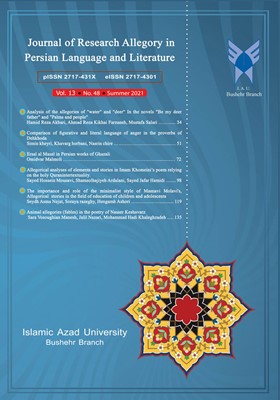-
-
List of Articles
-
Open Access Article
1 - Analysis of the allegories of "water" and "deer" In the novels "Be my deer father" and "Palms and people"
hamidreza akbari ahmadreza keikhay farzane mostafa salari -
Open Access Article
2 - Comparison of figurative and literal language of anger in the proverbs of Dehkhoda
simin khyri khavar ghorbani nasrin chireh -
Open Access Article
3 - Ersal al Masal in Persian works of Ghazali
omidvar malmoli -
Open Access Article
4 - Allegorical analyses of elements and stories in Imam Khomeini’s poem relying on the holy Quranintertextuality.
Sayed Hossein Mousavi Shamsolhajiyeh Ardalani Sayed Jafar Hamidi -
Open Access Article
5 - The importance and role of the minimalist style of Masnavi Molavi's, Allegorical stories in the field of education of children and adolescents
seydh asma nejat Soraya razeghy Hengamh Ashori -
Open Access Article
6 - Animal allegories (fables) in the poetry of Nasser Keshavarz
sara vosogyan mansh jalil nazary mohamad hady khalg zade
-
The rights to this website are owned by the Raimag Press Management System.
Copyright © 2021-2025







